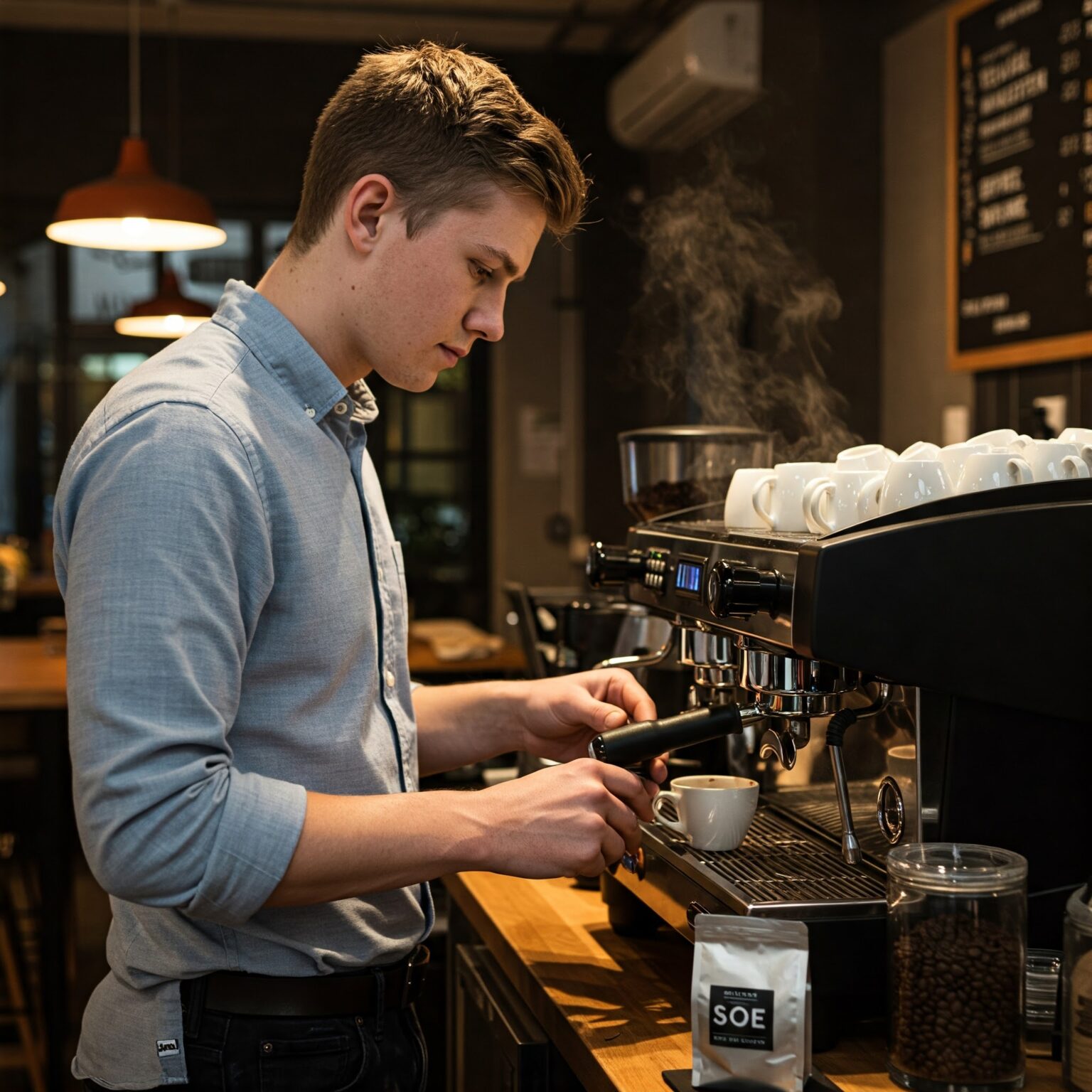Matching Food and Desserts with SOE Single Origin Espresso
Wiki Article
Comprehending Coffee Beans: the Journey From Espresso to Blended Coffee Beans

The Origins of Coffee: A Worldwide Point Of View
While you could assume of coffee as a modern-day staple, its origins map back centuries, intertwining with societies across the globe. The story begins in Ethiopia, where tale says a goat herdsman called Kaldi discovered the energizing impacts of coffee beans after observing his goats romping vigorously after consuming them.As trade courses increased, coffee made its way to Europe in the 17th century, rapidly acquiring appeal. It changed from a magical drink right into a daily ritual, intellectual exchanges and motivating gatherings. Each culture included its unique twist to coffee prep work, enriching its background. This international journey highlights just how coffee connects us, transcending boundaries and joining diverse traditions with a straightforward bean.
Farming and Harvesting of Espresso Beans
As coffee's journey progressed, the focus changed to the cultivation and harvesting of certain bean varieties, specifically those used for espresso. You'll discover that coffee beans frequently originate from Arabica or Robusta plants, each offering distinct flavors. The perfect expanding problems include high altitudes and rich, well-drained soil, which boost the beans' high quality.During the harvest, selecting methods vary. Timing is crucial; you want to collect when the cherries reach peak ripeness for optimum taste.
Once gathered, the beans are planned for processing, which is crucial in establishing their last taste. Recognizing the growing and collecting processes gives you insight right into what goes into your preferred coffee, enriching your admiration for every mug.
Handling Approaches: From Cherry to Bean
Now that you've found out about harvesting coffee beans, allow's discover exactly how those cherries transform right into the coffee beans you love. You'll see exactly how various harvesting techniques impact flavor, complied with by the crucial actions of fermentation and drying out. We'll break down the milling and grading procedure that determines your coffee's high quality.Collecting Strategies Described
When it pertains to coffee, recognizing harvesting methods is necessary, because they directly influence the flavor and high quality of the beans you appreciate. There are two main methods: selective picking and strip selecting. Selective selecting involves hand-picking just ripe cherries, guaranteeing you get the very best high quality beans. This method commonly brings about a richer flavor account, though it's even more labor-intensive. On the various other hand, strip choosing ways gathering all cherries at the same time, despite perfection. While it's quicker and more affordable, this can lead to a mix of flavors, influencing the end product. Eventually, the choice of collecting technique can considerably influence your coffee experience, so it deserves recognizing exactly how those beans made it to your mug.Fermentation and Drying Out
After harvesting, the following actions in processing coffee beans play a considerable role in forming their flavor. You'll locate that fermentation is crucial, as it assists damage down the mucilage surrounding the beans, enhancing their taste account. Relying on the technique, this process can last from a few hours to numerous days, with varying results based upon temperature and humidity.As soon as fermentation is total, drying out complies with, which is similarly essential. You can pick from mechanical or sun-drying drying methods. Sun-drying permits the beans to soak up tastes from the setting, while mechanical drying guarantees regular dampness degrees no matter of climate. Proper drying is essential to stop mold and mildew and preserve the beans' top quality, inevitably affecting your cup of coffee.
Milling and Grading Refine
As fermentation and drying set the stage for taste development, the milling and grading procedure guarantees that only the very best coffee beans make it to your cup. This stage includes getting rid of the outer layers of the coffee cherry, including the parchment and husk. After milling, the beans are sorted by dimension and weight, making sure an uniform quality. You'll find that grading helps determine problems and categorize beans, which influences taste and aroma. Top quality beans obtain a greater quality, leading to a richer coffee experience. As soon as graded, the beans await packaging and delivery, protecting their special characteristics. This thorough process is important for supplying the phenomenal preference you appreciate in every sip of your favorite brew.Toasting Strategies: Unlocking Flavor Potential
When you roast coffee beans, the technique you choose can substantially influence the flavor account. Comprehending the connection in between time, temperature level, and roasting strategies is vital to revealing the possibility of your mixture. Let's check out just how these elements come together to develop the excellent mug.Roasting Methods Clarified
While you might think that all coffee roasting approaches yield the same outcomes, the reality is that each method discloses distinct taste possibilities in the beans. You can choose in between SOE approaches like drum roasting, air roasting, or perhaps typical pan roasting. Drum toasting makes use of a rotating drum to equally disperse heat, improving caramelization and creating a well balanced flavor. Air roasting, on the other hand, flows warm air around the beans, advertising a lighter roast with obvious level of acidity. Pan toasting allows for hands-on control however requires consistent focus to avoid burning. Each technique has its nuances, so exploring with various methods can aid you find the excellent roast that straightens with your preference choices. Delight in the journey of discovering your excellent mug!
Effect On Flavor Account
Different toasting approaches not just affect the procedure however also greatly impact the taste account of the coffee beans. Dark roasts, on the various other hand, bring out strong, great smoky tastes, often concealing the bean's distinct features. Recognizing these subtleties helps you appreciate the virtuosity behind your cup of coffee, improving your overall experience with every sip.Time and Temperature Level Elements
To release the complete flavor potential of coffee beans, both time and temperature level during the roasting process play significant duties. When roasting, you'll locate that greater temperature levels can swiftly develop flavors, however if you rush it, you could finish up with burned notes. On the other hand, lower temperatures permit an extra steady flavor development, showcasing the beans' unique features.
Timing is simply as essential; expanding the roast too long can bring about a loss of level of acidity and illumination, while also short a roast might leave the beans underdeveloped. Finding that wonderful spot calls for technique and experimentation. By changing these variables, you can reveal the abundant, complex tastes hidden within each bean, creating a really exceptional coffee experience.
The Art of Blending: Crafting Unique Coffee Accounts

Start by choosing a base coffee that supplies a solid structure. A brilliant Ethiopian bean can bring fruitiness, while an abundant Brazilian coffee includes body.
As you mix, remember that each combination narrates. You're not just making coffee; you're developing an experience. So, take your time, preference regularly, and appreciate the trip of finding your signature blend.
Developing Techniques: How Preparation Influences Flavor
Mixing coffee opens a domain of flavor possibilities, but exactly how you make that mix can significantly affect your last cup. Different brewing techniques extract distinct tastes and fragrances, so it's essential to choose intelligently. A French press enables debris and oils to stay, producing a rich, robust experience. On the various other hand, a pour-over highlights the coffee's clearness and brightness, ideal for showcasing fragile notes.Coffee, with its high pressure, produces a concentrated shot that highlights sweetness and crema. If you favor a lighter mixture, take into consideration a chilly brew approach; it produces a smooth, less acidic taste.
Eventually, testing is key. Changing variables like water temperature level, grind size, and brew time can transform your coffee's account. So, accept the art of developing to discover the tastes hidden in your coffee blends. The right technique can raise your experience to new elevations.
The Future of Coffee: Sustainability and Development
As the coffee industry progresses, sustainability and advancement are becoming essential for addressing environmental challenges and meeting customer demands. You'll notice that even more coffee business are embracing green techniques, from sourcing beans ethically to executing sustainable farming techniques. These shifts not just assist the earth but additionally enhance the top quality of the coffee you enjoy.You may see advancements like eco-friendly packaging and water-saving developing methods that lower waste. Advanced modern technology, such as blockchain, is also coming to be prominent, ensuring openness in the supply chain, which enables you to trace your coffee back to its beginnings.
On top of that, purchasing local neighborhoods and supporting farmers with reasonable trade efforts fosters a more sustainable coffee community. As you sip your following mug, keep in mind that your choices can add to a brighter future for coffee. By going with sustainable brand names, you're not simply taking pleasure in a drink; you're making a favorable effect on the globe.
Frequently Asked Questions
What Is the Difference Between Arabica and Robusta Beans?
Arabica beans are smoother, sweeter, and have a higher acidity, while robusta beans are stronger, much more bitter, and have more caffeine. When brewing your coffee., you'll see these distinctions in flavor and scent.Exactly How Does Elevation Affect Coffee Bean Flavor?
Altitude impacts coffee bean flavor substantially. Higher elevations create beans with brighter level of acidity and complex flavors, while lower altitudes typically produce beans that are heavier and much less nuanced. You'll discover these differences in your cup!What Are the Health Advantages of Drinking Coffee?
Drinking coffee can improve your energy, improve psychological focus, and even improve physical efficiency. It's abundant in anti-oxidants, may reduce the danger of certain diseases, and can advertise a much healthier metabolic process when consumed in small amounts.Can Coffee Beans Be Recycled for Brewing?
Yes, you can reuse coffee beans for brewing, yet the flavor could be weak. If you delight in trying out, attempt recycling them in different ways, like cold mixtures or adding to smoothies for an extra kick.How Should I Shop Coffee Beans for Freshness?
To maintain your coffee beans fresh, store them in an airtight container in an amazing, dark area. Avoid exposing them to light, heat, or dampness, as these factors can swiftly degrade their flavor and scent.Recognizing Coffee Beans: the Journey From Coffee to Blended Coffee Beans.
Currently that you have actually learned about collecting espresso beans, allow's discover how those cherries transform into the coffee beans you enjoy.When you roast coffee beans, the method you choose can dramatically impact the flavor profile - Single Origin Espresso.While you may assume that all coffee toasting methods generate the very same results, the truth is that each method exposes one-of-a-kind flavor capacities in the beans.Various toasting methods not just affect the procedure yet likewise considerably impact the flavor profile of the coffee beans
Report this wiki page